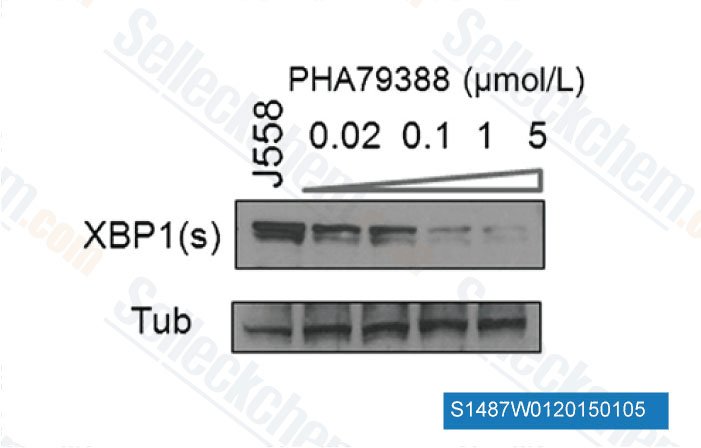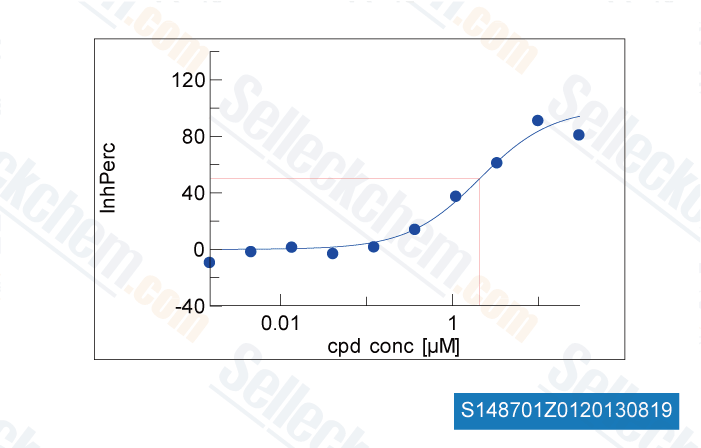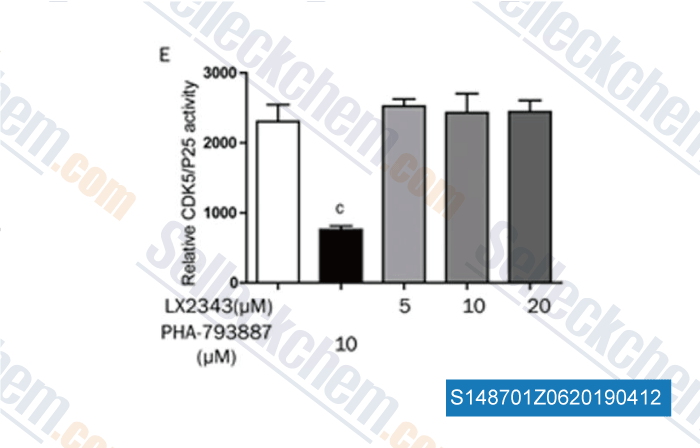|
Toll Free: (877) 796-6397 -- USA and Canada only -- |
Fax: +1-832-582-8590 Orders: +1-832-582-8158 |
Tech Support: +1-832-582-8158 Ext:3 Please provide your Order Number in the email. |
Technical Data
| Formula | C19H31N5O2 |
||||||
| Molecular Weight | 361.48 | CAS No. | 718630-59-2 | ||||
| Solubility (25°C)* | In vitro | DMSO | 72 mg/mL (199.18 mM) | ||||
| Ethanol | 72 mg/mL (199.18 mM) | ||||||
| Water | Insoluble | ||||||
| In vivo (Add solvents to the product individually and in order) |
|
||||||
|
* <1 mg/ml means slightly soluble or insoluble. * Please note that Selleck tests the solubility of all compounds in-house, and the actual solubility may differ slightly from published values. This is normal and is due to slight batch-to-batch variations. * Room temperature shipping (Stability testing shows this product can be shipped without any cooling measures.) |
|||||||
Preparing Stock Solutions
Biological Activity
| Description | PHA-793887 is a novel and potent inhibitor of CDK2, CDK5 and CDK7 with IC50 of 8 nM, 5 nM and 10 nM. It is greater than 6-fold more selective for CDK2, 5, and 7 than CDK1, 4, and 9. PHA-793887 induces cell-cycle arrest and apoptosis. Phase 1. | |||||||||||
|---|---|---|---|---|---|---|---|---|---|---|---|---|
| Targets |
|
|||||||||||
| In vitro | PHA-793887 has low activity against CDK1, CDK4, CDK9 and GSK3β with IC50 of 60 nM, 62 nM, 138 nM and 79 nM, respectively. PHA-793887 inhibits cell proliferation of many tumor cell lines, including A2780, HCT-116, COLO-205, C-433, DU-145, A375, PC3, MCF-7, and BX-PC3, with IC50 of 88 nM–3.4 μM. PHA-793887 (1 μM) shows a decrease in the S phase, a subsequent increase of the G1 phase and a slight accumulation of G2/M phase in A2780 cells. PHA-793887 (3 μM) significantly increases G2/M phase and reduces DNA synthsis. [1] PHA-793887 is cytotoxic for leukemic cell lines, including K562, KU812, KCL22, and TOM1, with IC50 of 0.3–7 μM, but it is not cytotoxic for normal unstimulated peripheral blood mononuclear cells or CD34+ hematopoietic stem cells. In colony assays, PHA-793887 shows very high activity against leukemia cell lines with IC50 less than 0.1 μM. PHA-793887 induces cell-cycle arrest, inhibits Rb and nucleophosmin phosphorylation, and modulates cyclin E and cdc6 expression at 0.2−1 μM and induces apoptosis at 5 μM. [2] | |||||||||||
| In vivo | PHA-793887 (10–30 mg/kg) shows good efficacy in the human ovarian A2780, colon HCT-116, and pancreatic BX-PC3 carcinoma xenograft models. [1] PHA-793887 (20 mg/kg) is effective in xenograft models of K562 and HL60 cells, primary leukemic disseminated model, and a high-burden disseminated ALL-2 model derived from a relapsed Philadelphia-positive acute lymphoid leukemia patient. [2] | |||||||||||
| Features | Multi-CDK inhibitor. |
Protocol (from reference)
| Kinase Assay:[3] |
|
|---|---|
| Cell Assay:[1] |
|
| Animal Study:[1] |
|
References
|
Customer Product Validation

-
Data from [Data independently produced by Mol Cancer Ther, 2014, 13(3), 662-74]

-
,

-
Data from [Data independently produced by , , Acta Pharmacol Sin, 2017, 38(8):1104-1119]
Selleck's PHA-793887 has been cited by 15 publications
| Identification and subsequent validation of transcriptomic signature associated with metabolic status in endometrial cancer [ Sci Rep, 2023, 13(1):13763] | PubMed: 37612452 |
| Identification and subsequent validation of transcriptomic signature associated with metabolic status in endometrial cancer [ Sci Rep, 2023, 13(1):13763] | PubMed: 37612452 |
| Sigma non-opioid receptor 1 is a potential therapeutic target for long QT syndrome [ Nat Cardiovasc Res, 2022, 1(2):142-156] | PubMed: 36051854 |
| Predicting heterogeneity in clone-specific therapeutic vulnerabilities using single-cell transcriptomic signatures [ Genome Med, 2021, 13(1):189] | PubMed: 34915921 |
| The Global Phosphorylation Landscape of SARS-CoV-2 Infection [ Cell, 2020, 182(3):685-712.e19] | PubMed: 32645325 |
| The Global Phosphorylation Landscape of SARS-CoV-2 Infection [ Cell, 2020, 182(3):685-712.e19] | PubMed: 32645325 |
| Dynamic Phosphorylation and Dephosphorylation of Cyclase-Associated Protein 1 by Antagonistic Signaling through Cyclin-Dependent Kinase 5 and cAMP Are Critical for the Protein Functions in Actin Filament Disassembly and Cell Adhesion. [ Mol Cell Biol, 2020, 40(4)] | PubMed: 31791978 |
| The TRAPP complex mediates secretion arrest induced by stress granule assembly. [ EMBO J, 2019, 38(19):e101704] | PubMed: 31429971 |
| Cell cycle-dependent phosphorylation of PRPS1 fuels nucleotide synthesis and promotes tumorigenesis [ Cancer Res, 2019, 10.1158/0008-5472.CAN-18-2486] | PubMed: 31253668 |
| MultiBacMam Bimolecular Fluorescence Complementation (BiFC) tool-kit identifies new small-molecule inhibitors of the CDK5-p25 protein-protein interaction (PPI) [ Sci Rep, 2018, 8(1):5083] | PubMed: 29572554 |
RETURN POLICY
Selleck Chemical’s Unconditional Return Policy ensures a smooth online shopping experience for our customers. If you are in any way unsatisfied with your purchase, you may return any item(s) within 7 days of receiving it. In the event of product quality issues, either protocol related or product related problems, you may return any item(s) within 365 days from the original purchase date. Please follow the instructions below when returning products.
SHIPPING AND STORAGE
Selleck products are transported at room temperature. If you receive the product at room temperature, please rest assured, the Selleck Quality Inspection Department has conducted experiments to verify that the normal temperature placement of one month will not affect the biological activity of powder products. After collecting, please store the product according to the requirements described in the datasheet. Most Selleck products are stable under the recommended conditions.
NOT FOR HUMAN, VETERINARY DIAGNOSTIC OR THERAPEUTIC USE.
